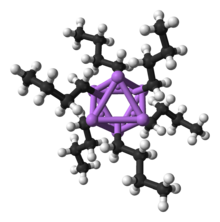Lithium compounds are compounds containing the element lithium (Li). These compounds usually take the +1 oxidation state, although the 0 oxidation state is known.
Inorganic compounds

Lithium forms salt-like derivatives with all halides and pseudohalides. Some examples include the halides LiF, LiCl, LiBr, LiI, as well as the pseudohalides and related anions. Lithium carbonate has been described as the most important compound of lithium. [1] This white solid is the principal product of beneficiation of lithium ores. It is a precursor to other salts including ceramics and materials for lithium batteries.
The compounds
LiBH
4 and
LiAlH
4 are useful
reagents. These salts and many other lithium salts exhibit distinctively high solubility in ethers, in contrast with salts of heavier alkali metals.
In aqueous solution, the coordination complex [Li(H2O)4+ predominates for many lithium salts. Related complexes are known with amines and ethers.
Organic chemistry
Organolithium compounds are numerous and useful. They are defined by the presence of a bond between carbon and lithium. They serve as metal-stabilized carbanions, although their solution and solid-state structures are more complex than this simplistic view. [2] Thus, these are extremely powerful bases and nucleophiles. They have also been applied in asymmetric synthesis in the pharmaceutical industry. For laboratory organic synthesis, many organolithium reagents are commercially available in solution form. These reagents are highly reactive, and are sometimes pyrophoric.
Like its inorganic compounds, almost all organic compounds of lithium formally follow the duet rule (e.g., BuLi, MeLi). However, it is important to note that in the absence of coordinating solvents or ligands, organolithium compounds form dimeric, tetrameric, and hexameric clusters (e.g., BuLi is actually [BuLi]6 and MeLi is actually [MeLi]4) which feature multi-center bonding and increase the coordination number around lithium. These clusters are broken down into smaller or monomeric units in the presence of solvents like dimethoxyethane (DME) or ligands like tetramethylethylenediamine (TMEDA). [3] As an exception to the duet rule, a two-coordinate lithate complex with four electrons around lithium, [Li(thf)4+[((Me3Si)3C)2Li]–, has been characterized crystallographically. [4]
See also
References
-
^ Cite error: The named reference
Greenwoodwas invoked but never defined (see the help page). - ^ Sapse, Anne-Marie & von R. Schleyer, Paul (1995). Lithium chemistry: a theoretical and experimental overview. Wiley-IEEE. pp. 3–40. ISBN 978-0-471-54930-7. Archived from the original on 31 July 2016.
- ^ Nichols, Michael A.; Williard, Paul G. (1993-02-01). "Solid-state structures of n-butyllithium-TMEDA, -THF, and -DME complexes". Journal of the American Chemical Society. 115 (4): 1568–1572. doi: 10.1021/ja00057a050. ISSN 0002-7863.
-
^ C., Mehrotra, R. (2009). Organometallic chemistry : a unified approach. [Place of publication not identified]: New Age International Pvt.
ISBN
978-8122412581.
OCLC
946063142.
{{ cite book}}: CS1 maint: multiple names: authors list ( link)
Lithium compounds are compounds containing the element lithium (Li). These compounds usually take the +1 oxidation state, although the 0 oxidation state is known.
Inorganic compounds

Lithium forms salt-like derivatives with all halides and pseudohalides. Some examples include the halides LiF, LiCl, LiBr, LiI, as well as the pseudohalides and related anions. Lithium carbonate has been described as the most important compound of lithium. [1] This white solid is the principal product of beneficiation of lithium ores. It is a precursor to other salts including ceramics and materials for lithium batteries.
The compounds
LiBH
4 and
LiAlH
4 are useful
reagents. These salts and many other lithium salts exhibit distinctively high solubility in ethers, in contrast with salts of heavier alkali metals.
In aqueous solution, the coordination complex [Li(H2O)4+ predominates for many lithium salts. Related complexes are known with amines and ethers.
Organic chemistry
Organolithium compounds are numerous and useful. They are defined by the presence of a bond between carbon and lithium. They serve as metal-stabilized carbanions, although their solution and solid-state structures are more complex than this simplistic view. [2] Thus, these are extremely powerful bases and nucleophiles. They have also been applied in asymmetric synthesis in the pharmaceutical industry. For laboratory organic synthesis, many organolithium reagents are commercially available in solution form. These reagents are highly reactive, and are sometimes pyrophoric.
Like its inorganic compounds, almost all organic compounds of lithium formally follow the duet rule (e.g., BuLi, MeLi). However, it is important to note that in the absence of coordinating solvents or ligands, organolithium compounds form dimeric, tetrameric, and hexameric clusters (e.g., BuLi is actually [BuLi]6 and MeLi is actually [MeLi]4) which feature multi-center bonding and increase the coordination number around lithium. These clusters are broken down into smaller or monomeric units in the presence of solvents like dimethoxyethane (DME) or ligands like tetramethylethylenediamine (TMEDA). [3] As an exception to the duet rule, a two-coordinate lithate complex with four electrons around lithium, [Li(thf)4+[((Me3Si)3C)2Li]–, has been characterized crystallographically. [4]
See also
References
-
^ Cite error: The named reference
Greenwoodwas invoked but never defined (see the help page). - ^ Sapse, Anne-Marie & von R. Schleyer, Paul (1995). Lithium chemistry: a theoretical and experimental overview. Wiley-IEEE. pp. 3–40. ISBN 978-0-471-54930-7. Archived from the original on 31 July 2016.
- ^ Nichols, Michael A.; Williard, Paul G. (1993-02-01). "Solid-state structures of n-butyllithium-TMEDA, -THF, and -DME complexes". Journal of the American Chemical Society. 115 (4): 1568–1572. doi: 10.1021/ja00057a050. ISSN 0002-7863.
-
^ C., Mehrotra, R. (2009). Organometallic chemistry : a unified approach. [Place of publication not identified]: New Age International Pvt.
ISBN
978-8122412581.
OCLC
946063142.
{{ cite book}}: CS1 maint: multiple names: authors list ( link)